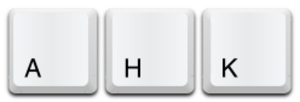AutoHotkey facts for kids
 |
|
| Developer(s) | Chris Mallett, Steve Gray |
|---|---|
| Initial release | November 10, 2003 (Chris Mallet) July 18, 2008 (Steve Gray) |
| Stable release | |
| Operating system | Microsoft Windows |
| Type | Scripting language Automation GUI utility |
| License | GPLv2 |
AutoHotkey is a free computer program for Microsoft Windows computers. It helps you automate tasks and create your own keyboard shortcuts. Think of it as a tool that lets you teach your computer to do things automatically. You can make your own "hotkeys" (special keyboard shortcuts) or "macros" (a series of actions). This makes repetitive tasks much faster and easier. AutoHotkey is great for anyone who wants to make their computer work smarter for them. It comes with a helpful guide to get you started.
Contents
What AutoHotkey Can Do
AutoHotkey scripts are like mini-programs you write to tell your computer what to do. They can help you do many cool things.
Create Custom Shortcuts
You can use AutoHotkey to launch programs or open documents with just a few key presses. For example, you could set up a shortcut so that pressing Ctrl opens your favorite internet browser. You can also change what certain keys do. Maybe you want Ctrl to type a long dash instead of its usual action.
Automate Typing with Hotstrings
AutoHotkey has a feature called "hotstrings." These automatically replace text as you type it. For instance, if you type "btw," AutoHotkey can instantly change it to "by the way." This is super handy for words or phrases you use often.
Run Tasks Automatically
You can set up scripts to run by themselves when your computer starts. This means they can do things like organize your files without you even touching the keyboard.
Advanced Features
For more complex tasks, AutoHotkey can create custom pop-up windows for you to enter information. It can also work with your computer's system settings. You can even turn your scripts into standalone programs that can run on other computers.
Cool Uses for AutoHotkey
- Change your keyboard layout, like from QWERTY to Dvorak.
- Type common phrases or filenames quickly with shortcuts.
- Easily type special characters not on your keyboard, like curved quotes or the multiplication sign (×).
- Control your mouse cursor using only your keyboard.
- Open programs, documents, or websites with simple key presses.
- Add your signature to emails or online posts automatically.
- Keep an eye on your system and close programs you don't want.
- Set up automatic reminders, system scans, or backups.
- Fill out online forms automatically.
- Quickly test out ideas for new software.
AutoHotkey's Journey
AutoHotkey was first released on November 10, 2003. The creator, Chris Mallett, wanted to add hotkey support to another program called AutoIt. When that didn't happen, he decided to build AutoHotkey from scratch. He based its rules on AutoIt v2.
AutoHotkey Version 2
In 2010, a new version called AutoHotkey v1.1 became the main version for ongoing updates. Later, in July 2021, the first test version of AutoHotkey v2 was released. The official version 2.0.0 came out on December 20, 2022. By January 22, 2023, AutoHotkey v2 became the main version that everyone should use. The older v1.1 version stopped getting new features, but it was still supported for a while. The final update for v1.1 was released on March 16, 2024, and it is no longer supported.
Simple Examples
Here are a couple of simple examples to show how AutoHotkey scripts work.
Google Search Shortcut
This script lets you quickly search on Google. First, copy some text from any program to your computer's clipboard. Then, press Win. AutoHotkey will open your web browser and search for the text you copied!
#g::Run "https://www.google.com/search?q=" . A_ClipboardTyping Shortcut (Hotstring)
This script creates a "hotstring." If you type afaik in any program and then press a space or enter, AutoHotkey will automatically change it to "as far as I know."
::afaik::as far as I knowAdd-ons and Plugins
People have created many extra tools and plugins that work with AutoHotkey. These allow it to connect with other programming languages and add even more features.
Other Programming Languages
AutoHotkey can work with languages like:
Extra Features and Tools
Some major plugins add support for:
- Making parts of programs work together.
- Talking to the computer's command line.
- Creating new code while a program is running.
- Working with different computer devices.
- Automating tasks in Internet Explorer.
- Creating GUI windows.
- Connecting to online services.
- Setting up special actions when things happen in Windows.
Important Note on Malware
Sometimes, people use AutoHotkey to create programs that are not good, like malware. When antivirus software tries to find these bad programs, it might sometimes mistakenly think AutoHotkey itself is the problem. This is because the bad program uses parts of AutoHotkey to run. It's important to remember that AutoHotkey is just a tool, and like any tool, it can be used for good or bad purposes.
See also
 In Spanish: AutoHotkey para niños
In Spanish: AutoHotkey para niños
- AutoIt (another automation tool for Windows)
- AutoKey (a similar tool for Linux)
- Automator (a similar tool for Macintosh)
- Bookmarklet (small programs for web browsers)
- iMacros (a tool for web browsers)
- Keyboard Maestro (a tool for Macintosh)

